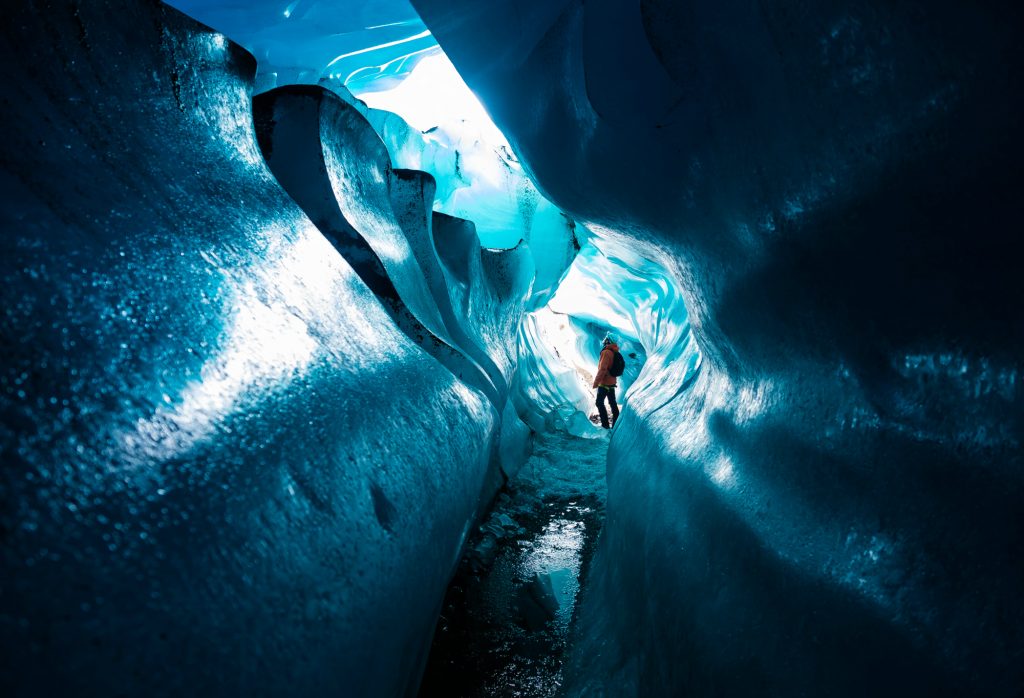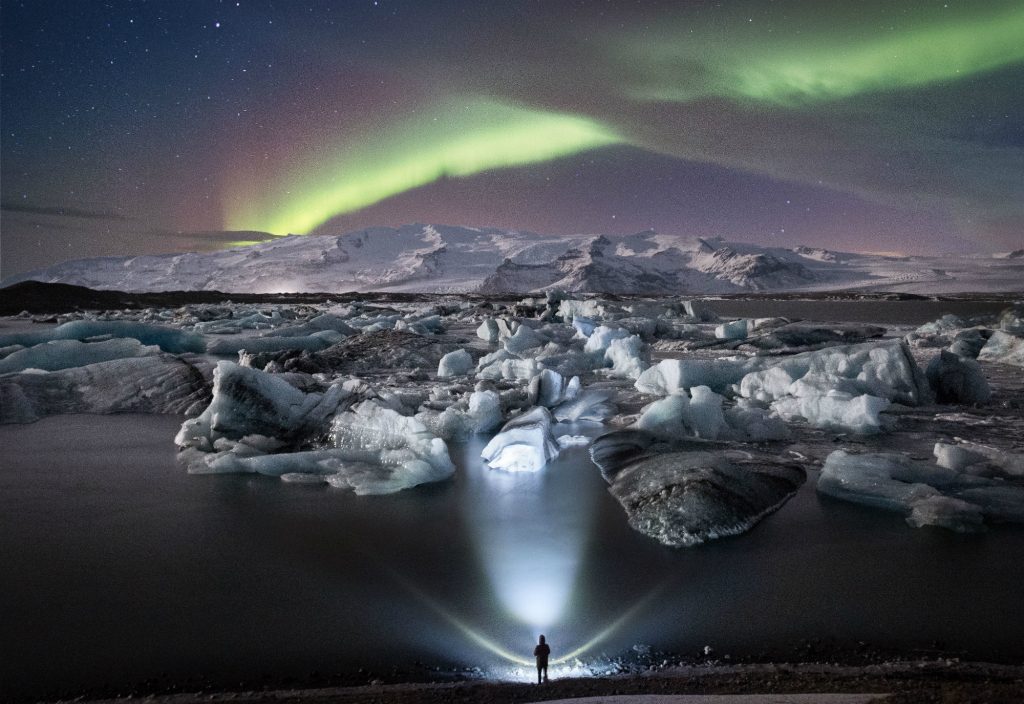The day starts with watching the sunrise through the broken shards of ice on the Black Diamond beach, appropriately named because of its black sand. By mid-morning, guests marvel at the floating icebergs freshly calved from Europe’s largest glacier at the Jökulsarlon Glacier Lagoon. Then they spend the balance of the day hiking on a glacier aptly named Falljökull (the Falling Glacier). Blue ice, crevasses, bottomless holes, and the occasional ice cave make Iceland an adventurer’s playground and a photographer’s dream.

What makes the experience of traveling in Iceland so visceral, however, is not just the otherworldly views, but the temporary nature of it all. The phrase “beauty is fleeting” is especially accurate in describing the country’s natural landscape, which is currently in heavy flux due to the effects of climate change. In fact, the glacier lagoon itself is a product of a changing climate. The distant glacier feeding the lagoon with icebergs has been receding for the past 50 years at an unprecedented rate. The lagoon is now eight kilometers from the sea.
When our company, Hidden Iceland, runs our two-day trip in southern Iceland toward the Vatnajökull National Park in the southeast, our clients admire the sunrise, snap photos of icebergs, and hike across the glacier, but we understand the importance of framing this experience in a critical and significant way. This is a fragile and ever-changing environment demanding respect and expertise. Our glacier guides are safe and experienced but also acutely aware of the glacier's past and uncertain future.
Hiking on a glacier is an immersive experience. The colors, the cold, and the exertion all add to the memories travelers create, especially when, after a day of feeling awed by their surroundings, the guide confides, “Everything you have experienced today will be different tomorrow. Changed by next week. And maybe gone by next year. Today is just for us.”
Glacier Guiding with Climate Change
Iceland’s glacier guides have a unique opportunity to share their knowledge of how climate change has shaped the landscape. Seeing an avalanche of ice tumble in the distance causes unwarranted alarm, but also gives the guide the chance to stop and explain that glaciers are in constant motion — pushing forward, cracking, falling, and, indeed, melting. This is a natural phenomenon unrelated to the rapidly warming Earth. But, the guide explains, “it is the speed in which the glaciers are melting that is so alarming.”
Walking onward, the guide alerts travelers to obvious scars nearly 100 meters up the mountainside where the glacier scratched past a mere 40 years prior. While snapping pictures along the edge of a lagoon one kilometer wide situated in front of the glacier, the guide confirms what travelers may, by now, suspect: "This lagoon was glacier ice at the turn of the century. We have lost more ice from melting in the past 20 years than in the previous century, and it is all because the area’s average temperature has risen. These glaciers, near sea level, are the first to go when temperatures rise, even by the tiniest amount."

Over the next several hours exploring the glacier, the guide continues to educate travelers about the science of moving ice but is always ready to answer the anticipated questions about the glacier’s future. More than 90 percent of all alpine glaciers are globally retreating at unprecedented levels. In only a few years, Iceland’s remaining glaciers may be tucked high in the mountains — the only area cold enough to stay frozen. And this glacier walk — an experience that will likely stick in travelers’ minds for years to come — may no longer be an itinerary activity but rather something relegated to photos.
Turning Experiences Into Action
Some may think there’s an awkward dichotomy of enjoying nature with family and feeling the burden of climate change. At Hidden Iceland, we believe it adds to the immersion of the day. Guides have a duty to show travelers climate change is a tangible reality and the effects are taking place right under their feet. (To emphasize the point, our guides show a timelapse video from the Extreme Ice Survey of Sólheimajökull Glacier, which shows the creation of a brand new lagoon from the remnants of the glacier.)
Several recent polls confirm most people believe in climate change, and infusing this educational component into our adventurous activities empowers our travelers to be part of the solution. Following these trips, we see our travelers’ attitudes change as they contemplate what needs to be done immediately on both the individual and global levels.
These experiences don’t leave travelers wallowing in anguish, however. There is always a feeling of hope. They ask what can be done, and how they can make changes in their everyday lives. Hidden Iceland’s advice varies from person to person and includes suggestions of eating less meat, choosing local produce, offsetting flights and car emissions, and reducing the use of plastic. Even planting trees in a local park or garden helps. But the one piece of advice that is always the same is we tell our customers to share what they saw: Show others the effects of climate change are already in full swing. Spread the word and change minds. It’s not too late for us to slow down this process and let nature adapt.
If we don’t offer solutions, then the memory fades into inaction. Hidden Iceland maintains strict sustainable tourism ideals about leaving each area the same as when we arrived and aims to keep all waste and emissions to a minimum. But we are aware our operations create emissions, mainly due to the fuel from our vehicles, so every quarter we review our impact, then offset all our carbon emissions by investing in renewable energy sources around the world, such as wind farms in India.
Hidden Iceland partners with UK-based company Climate Care to offset our carbon footprint, and we’ve maintained carbon neutrality since our first day in business. We encourage individuals to also offset their travels, and they’re often surprised by how inexpensive this is. Previous guests from as far away as Turks and Caicos tell us they now offset the same way our company does.
Beyond the Glaciers
The reality is the world is changing. Glaciers offer a good visual example of how climate change is affecting the natural landscape, but more subtle changes are also already underway. When we take our guests onto the volcanic Westman Islands to visit one of the biggest puffin colonies in the world, guides explain the number of puffins in Iceland has dropped from 7 million at their peak to around 5.4 million in a very short period of time. The birds are running out of their main food source, the sand eel, because of rising sea temperatures brought on by climate change.

Conversely, according to the Arctic Fox Sanctuary in the West Fjords, increased temperatures have led to less harsh winters. This means there have been more migrating birds coming to Iceland, such as fulmar and geese, and the elusive Arctic fox is able to hunt more successfully.
Regardless of whether climate change’s effects are perceived as positive or negative, it is not only interesting to share these stories and this information with travelers; it is essential. Although we are focused primarily on giving our guests the best experience possible while in Iceland, we know a lot of what they see and feel is temporary. In Iceland, we are in a position to witness the lasting effects of climate change every single day — something that may not be so prevalent in other places around the world. Empowering travelers helps amplify the situation’s severity, ensuring we can continue to offer future travelers awe-inspiring experiences well into the future. Knowing all Hidden Iceland guides incorporate this sentiment into every tour and that even the smallest impression can lead to big changes is a welcoming thought and part of what gives us hope each and every time we venture out onto a glacier.
This article is part of an Adventure Travel Trade Association (ATTA) initiative addressing important topics identified as critical to the protection and continued advancement of the adventure travel industry. Each initiative — eliminating plastics, women in leadership, climate action, and young leaders — has a dedicated team focused on building awareness of, advancing educational opportunities in, and creating a lasting impact on each of these areas within the adventure travel industry. We invite you to visit the ATTA’s initiatives page where you can access reports, read the latest news, participate in active projects, and join conversations within the membership community.
